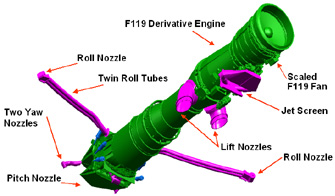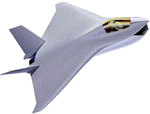Joint Strike Fighter (JSF)

| On October 26, 2001, the Defense Department selected Lockheed Martin's F-35 as the winner of the competition to manufacture the Joint Strike Fighter. Click here for more information. |
The 1993 Bottom-Up Review (BUR) determined that a separate tactical aviation modernization program by each Service was not affordable and canceled the Multi-Role Fighter (MRF) and Advanced Strike Aircraft (A/F-X) program. Acknowledging the need for the capability these canceled programs were to provide, the BUR initiated the Joint Advanced Strike Technology (JAST) effort to create the building blocks for affordable development of the next-generation strike weapons system. After a review of the program in August 1995, DoD dropped the "T" in the JAST program and the JSF program has emerged from the JAST effort. Fiscal Year 1995 legislation merged the Defense Advanced Research Projects Agency (DARPA) Advanced Short Take-off and Vertical Landing (ASTOVL) program with the JSF Program. This action drew the United Kingdom (UK) Royal Navy into the program, extending a collaboration begun under the DARPA ASTOVL program.
The JSF program will demonstrate two competing weapon system concepts for a tri-service family of aircraft to affordably meet these service needs:
USAF-Multi-role aircraft (primarily air-to-ground) to replace F-16 and A-10 and to complement F-22. The Air Force JSF variant poses the smallest relative engineering challenge. The aircraft has no hover criteria to satisfy, and the characteristics and handling qualities associated with carrier operations do not come into play. As the biggest customer for the JSF, the service will not accept a multirole F-16 fighter replacement that doesn't significantly improve on the original. USN-Multi-role, stealthy strike fighter to complement F/A-18E/F. Carrier operations account for most of the differences between the Navy version and the other JSF variants. The aircraft has larger wing and tail control surfaces to better manage low-speed approaches. The internal structure of the Navy variant is strengthened up to handle the loads associated with catapult launches and arrested landings. The aircraft has a carrier-suitable tailhook. Its landing gear has a longer stroke and higher load capacity. The aircraft has almost twice the range of an F-18C on internal fuel. The design is also optimized for survivability. USMC-Multi-role Short Take-Off & Vertical Landing (STOVL) strike fighter to replace AV-8B and F/A-18A/C/D. The Marine variant distinguishes itself from the other variants with its short takeoff/vertical landing capability. UK-STOVL (supersonic) aircraft to replace the Sea Harrier. Britain's Royal Navy JSF will be very similar to the U.S. Marine variant.The JSF concept is building these three highly common variants on the same production line using flexible manufacturing technology. Cost benefits result from using a flexible manufacturing approach and common subsystems to gain economies of scale. Cost commonality is projected in the range of 70-90 percent; parts commonality will be lower, but emphasis is on commonality in the higher-priced parts.
 |  The Lockheed Martin X-35 concept for the Marine and Royal Navy variant of the aircraft uses a shaft-driven lift-fan system to achieve Short-Takeoff/Vertical Landing (STOVL) capability. The aircraft will be configured with a Rolls-Royce/Allison shaft-driven lift-fan, roll ducts and a three-bearing swivel main engine nozzle, all coupled to a modified Pratt & Whitney F119 engine that powers all three variants. The Lockheed Martin X-35 concept for the Marine and Royal Navy variant of the aircraft uses a shaft-driven lift-fan system to achieve Short-Takeoff/Vertical Landing (STOVL) capability. The aircraft will be configured with a Rolls-Royce/Allison shaft-driven lift-fan, roll ducts and a three-bearing swivel main engine nozzle, all coupled to a modified Pratt & Whitney F119 engine that powers all three variants. |
 |  The Boeing X-32 JSF short takeoff and vertical landing (STOVL) variant for the U.S. Marine Corps and U.K. Royal Navy employs a direct lift system for short takeoffs and vertical landings with uncompromised up-and-away performance. The Boeing X-32 JSF short takeoff and vertical landing (STOVL) variant for the U.S. Marine Corps and U.K. Royal Navy employs a direct lift system for short takeoffs and vertical landings with uncompromised up-and-away performance. |
Survivability: radio frequency/infrared signature reduction and on-board countermeasures to survive in the future battlefield--leveraging off F-22 air superiority mission supportJSF’s integrated avionics and stealth are intended to allow it to penetrate surface-to-air missile defenses to destroy targets, when enabled by the F-22’s air dominance. The JSF is designed to complement a force structure that includes other stealthy and non-stealthy fighters, bombers, and reconnaissance / surveillance assets. JSF requirements definition efforts are based on the principles of Cost as an Independent Variable: Early interaction between the warfighter and developer ensures cost / performance trades are made early, when they can most influence weapon system cost. The Joint Requirements Oversight Council has endorsed this approach.
Lethality: integration of on- and off-board sensors to enhance delivery of current and future precision weapons
Supportability: reduced logistics footprint and increased sortie generation rate to provide more combat power earlier in theater
Affordability: focus on reducing cost of developing, procuring and owning JSF to provide adequate force structure
The JSF’s approved acquisition strategy provides for the introduction of an alternate engine during Lot 5 of the production phase, the first high rate production lot. OSD is considering several alternative implementation plans which would accelerate this baseline effort.
Program Status
The focus of the program is producing effectiveness at an affordable price—the Air Force’s unit flyaway cost objective is $28 million (FY94$). This unit recurring flyaway cost is down from a projected, business as usual,cost of $36 million. The Concept Demonstration Phase (CDP) was initiated in November 1996 with the selection of Boeing and Lockheed Martin. Both contractors are: (1) designing and building their concept demonstration aircraft, (2) performing unique ground demonstrations, (3) developing their weapon systems concepts. First operational aircraft delivery is planned for FY08.
The JSF is a joint program with shared acquisition executive responsibilities. The Air Force and Navy each provide approximately equal shares of annual funding, while the United Kingdom is a collaborative partner, contributing $200 million to the CDP. CDP, also known as the Program Definition and Risk Reduction (PDRR) phase, consists of three parallel efforts leading to Milestone II and an Engineering and Manufacturing Development (EMD) start in FY01:
Concept Demonstration Program. The two CDP contracts were competitively awarded to Boeing and Lockheed Martin for ground and flight demonstrations at a cost of $2.2 billion for the 51-month effort, including an additional contract to Pratt & Whitney for the engine. Each CDP contractor will build concept demonstrator aircraft (designated X-32/35). Each contractor will demonstrate commonality and modularity, short take-off and vertical landing, hover and transition, and low-speed carrier approach handling qualities of their aircraft.
Technology Maturation. These efforts evolve key technologies to lower risk for EMD entry. Parallel technology maturation demonstrations are also an integral part of the CDP / PDRR objective of meeting warfighting needs at an affordable cost. Focus is on seven critical areas: avionics, flight systems, manufacturing and producibility, propulsion, structures and materials, supportability, and weapons. Demonstration plans are coordinated with the prime weapon system contractors and results are made available to all program industry participants.
Requirements Definition. This effort leads to Joint Operational Requirements Document completion in FY00; cost/performance trades are key to the process.



 Mission: The mission of the CH-46E Sea Knight helicopter in a Marine Medium Helicopter (HMM) squadron is to provide all-weather, day/night, night vision goggle (NVG) assault transport of combat troops, supplies, and equipment during amphibious and subsequent operations ashore. Troop assault is the primary function and the movement of supplies and equipment is secondary. Additional tasks are: combat and assault support for evacuation operations and other maritime special operations; over-water search and rescue augmentation; support for mobile forward refueling and rearming points; aeromedical evacuation of casualties from the field to suitable medical facilities.
Mission: The mission of the CH-46E Sea Knight helicopter in a Marine Medium Helicopter (HMM) squadron is to provide all-weather, day/night, night vision goggle (NVG) assault transport of combat troops, supplies, and equipment during amphibious and subsequent operations ashore. Troop assault is the primary function and the movement of supplies and equipment is secondary. Additional tasks are: combat and assault support for evacuation operations and other maritime special operations; over-water search and rescue augmentation; support for mobile forward refueling and rearming points; aeromedical evacuation of casualties from the field to suitable medical facilities.
